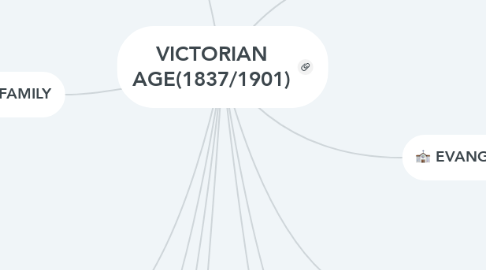
1. SOCIETY
1.1. aristocracy
1.2. working-class
1.3. middle class
1.3.1. upper middle class
1.3.1.1. Industrialists, bankers, businessmen, lawyers, members of the professions
1.3.2. lower middle class
1.3.2.1. Shopkeepers, commercial travellers, post office workers, civil servants, clerks
1.3.3. FEATURES
1.3.3.1. moralism
1.3.3.2. industry
1.3.3.3. sense of beauty
2. FAMILY
2.1. Reading the Bible
2.2. Moral teaching in art
2.3. Hypocrisy
2.4. Greed for material success
2.5. Educative books No scandalous subjects
2.6. patriarchal unit
2.7. The man represented the authority
3. PATRIOTISM
3.1. was influenced by ideas of racial superiority. The British had the convinction that the races of the world were divided by physical and intellectual differences, that some were destined to be led by others
3.2. The concept of “the white man’s burden” was exalted by the colonial writers, like Kipling, and the expansion of the empire was regarded as a mission
4. UTILITARIANISM
4.1. Contributed to the Victorian conviction that any problem could be overcome through reason. The key-words of this philosophy were: usefulness, happiness and avoidance of pain
5. HURBAN HABITAT
5.1. slums
5.2. atmosphere was polluted
5.3. The Government promoted an campaign against national ill health through: -cleaning up of the towns; -foundation of professional organisations to control medical education and research; building of modern hospitals.
5.4. new Victorian institutions like prisons, police stations, boarding schools, town halls
6. VICTORIAN NOVEL
6.1. A great number of novels were written by women but some women used a male pseudonym because for a woman it wasn’t easy to publish. The woman’s novel was an realistic exploration of the daily lives and values of women within the family and the community
6.2. THREE GROUPS
6.2.1. 1= Early-Victorian novel. Main writer was Charles Dickens. Themes: social and humanitarian.
6.2.2. 2=Mid- Victorian novel. Main writers: Bronte sisters and Robert Stevenson. Themes: Romantic and Gothic traditions and psychological vein
6.2.3. 3=Late- Victorian novel. Main writers: Thomas Hardy and Oscar Wilde. Themes: sense of dissatisfaction (insoddisfazione) with values of the age
6.3. The most common features: -There is a narrator that comment and erect a rigid barrier between right and wrong; -The setting often was the city, symbol of industrial civilisation and in the same time expression of anonymous lives; -The plot was long and complicated; -The analysis of the characters’ inner lives; -In the final chapter the events are explained and justified.
7. RESPECTABILITY
7.1. -The possession of good manners (buone maniere); -The ownership of a comfortable house with servants and a carriage; -Regular attendance at church; -Charitable activity. Philanthropy was a wide phenomenon that absorbed the energies of thousands of Victorians; -sex was considered a taboo
8. EVANGELICALISM
8.1. Obedience to a strict code of morality; Dedication to humanitarian causes and social reform.
9. REFORMS
9.1. The Victorian age began with the First Reform Act (1832), a great social achievement. It was a period of significant political, social and technological progress and expansion both economic and territorial.
9.1.1. TWO PROBLEMS
9.1.1.1. 1=a strong campaign for liberal trade that led to the abolition of the Corn Laws
9.1.1.2. 2=the Chartist: a working-class movement who called for social reforms and the extension of the right to vote
10. THE GREAT EXHIBITION(1851)
10.1. In Crystal Palace in London, celebrated British advances in science, technology and the Empire.
10.2. -invention of the newspaper = Defoe and Still -invention of the stamp = nation identification -circulating bookshops
11. AMERICAN CIVIL WAR(1861/1865)
11.1. The North was industrialised and the population was especially white (the immigrants from Europe settled in the North), the economy of the South was based on the vast plantations of tobaccos and cotton, and on the slavery
11.1.1. lasted four years (from 1861 to 1865) and ended with the abolition of slavery
11.1.1.1. american dream
11.1.1.2. self-made man
